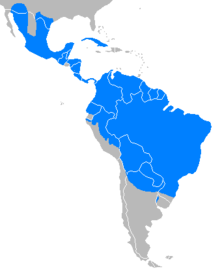| Collared peccary | |
|---|---|

| |
| Scientific classification | |
| Kingdom: | |
| Phylum: | |
| Class: | |
| Order: | |
| Family: | |
| Genus: | |
| Species: | P. tajacu
|
| Binomial name | |
| Pecari tajacu | |

| |
| Synonyms | |
|
Tayassu tajacu | |
The collared peccary (Pecari tajacu) is a species of mammal in the family Tayassuidae found in North, Central, and South America. They are commonly referred to as javelina, saíno or báquiro, although these terms are also used to describe other species in the family. The species is also known as the musk hog, Mexican hog, and javelina. In Trinidad, it is colloquially known as quenk.
Although somewhat related to the pigs and frequently referred to as one, this species and the other peccaries are no longer classified in the pig family, Suidae.
Description edit
The collared peccary stands around 510–610 millimetres (20–24 in) tall at the shoulder and about 1.0–1.5 m (3 ft 3 in – 4 ft 11 in) long. It weighs between 16 and 27 kg (35 and 60 lb).[2] The dental formula is as followed: 2/3,1/1,3/3,3/3.[3]. The peccary contains small tusks that point toward the ground when the collared peccary is upright. It also has slender legs with a robust or stocky body. The tail is often hidden in the coarse fur of the peccary. [4].
Range and habitat edit
The collared peccary is a widespread creature found throughout much of the tropical and subtropical Americas, ranging from the Southwestern United States to northern Argentina in South America. The only Caribbean island where it is native, however, is Trinidad, although introduced populations exist in Cuba. It inhabits deserts and xeric shrublands, tropical and subtropical grasslands, savannas, and shrublands, flooded grasslands and savannas, tropical and subtropical dry broadleaf forests, and several other habitats, as well. In addition, it is well adapted to habitats shared by humans, merely requiring sufficient cover; they can be found in cities and agricultural land throughout their range, where they consume garden plants. Notable populations are known to exist in the suburbs of Phoenix and Tucson, Arizona.[5][6]
Diet edit
Collared peccaries normally feed on cactus,mesquite beans, fruits, roots, tubers, palm nuts, grasses, invertebrates, and small vertebrates. In areas inhabited by humans, they will also consume cultivated crops and ornamental plants, such as tulip bulbs.[5][6]
Behavior edit
Collared peccaries are diurnal creatures that live in groups of up to 50 individuals, averaging between six and 9 members. They frequently sleep at night in burrows, often under the roots of trees, nut sometime they can be found in caves or under logs[7]. The collared peccary (javelina) are not totally diurnal. In central Arizona they are often active at night but less so during daytime.
Although they usually ignore humans, they will react if they feel threatened. They defend themselves with their long tusks, which can sharpen themselves whenever their mouths open or close. A collared peccary will release a strong musk or give a sharp bark if it is alarmed. [8].
References edit
- ^ Gongora, J.; Reyna-Hurtado, R.; Beck, H.; Taber, A.; Altrichter, M.; Keuroghlian, A. (2011). "Pecari tajacu". IUCN Red List of Threatened Species. 2011: e.T41777A10562361. doi:10.2305/IUCN.UK.2011-2.RLTS.T41777A10562361.en. Retrieved 27 October 2020.
- ^ "Collared Peccary: Javelina ~ Tayaussa ~ Musk Hog". Digital West Media Inc. Retrieved 8 January 2012.
- ^ Reid, Fiona (2006). Peterson Field Guide: Mammals of North America (4 ed.). New York, Ny: Houghton Mifflin Company. p. 158. ISBN 13: 978-0-395-93596.
{{cite book}}:|access-date=requires|url=(help); Check|isbn=value: invalid character (help) - ^ Reid, Fiona (2006). Peterson Field Guide: Mammals of North America (4 ed.). New York, Ny: Houghton Mifflin Company. p. 488. ISBN 13: 978-0-395-93596.
{{cite book}}:|access-date=requires|url=(help); Check|isbn=value: invalid character (help) - ^ a b Friederici, Peter (August–September 1998). "Winners and Losers". National Wildlife Magazine. 36 (5). National Wildlife Federation.
- ^ a b Sowls, Lyle K. (1997). Javelinas and Other Peccaries: Their Biology, Management, and Use (2 ed.). Texas A&M University Press. pp. 61–68. ISBN 978-0-89096-717-1.
- ^ Reid, Fiona (2006). Peterson Field Guide: Mammals of North America (4 ed.). New York, Ny: Houghton Mifflin Company. p. 488. ISBN 13: 978-0-395-93596.
{{cite book}}:|access-date=requires|url=(help); Check|isbn=value: invalid character (help) - ^ Reid, Fiona (2006). Peterson Field Guide: Mammals of North America (4 ed.). New York, Ny: Houghton Mifflin Company. p. 488. ISBN 13: 978-0-395-93596.
{{cite book}}:|access-date=requires|url=(help); Check|isbn=value: invalid character (help)
External links edit
- Smithsonian Institution - North American Mammals: Pecari tajacu
- Smithsonian Wild: Pecari tajacu
- Arizona Game and Fish Department – Living With Javelina
Peccary, Collared Peccary, Collared Peccary, Collared Peccary, Collared Peccary, Collared Category:Mammals of Guyana Category:Mammals of Brazil Peccary, Collared Category:Mammals of Costa Rica Category:Animals described in 1758 Category:Mammals of Guatemala Category:Mammals of the Caribbean Category:Mammals of Cuba

